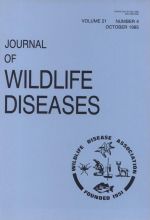Combinations of etorphine hydrochloride and xylazine hydrochloride in different dosages were tested for their efficacy as immobilizing agents on 16 recently captured feral mares in corrals. The results of these trials led to the utilization of a standard combination of 5.5 mg of etorphine hydrochloride, 150 mg of xylazine hydrochloride, and 3 mg of atropine sulfate in a 7-ml dart syringe for field capture. This combination was used, administered by dart gun from helicopters, to capture 87 free-ranging feral horses from about 80 bands. Five mares died at the time of capture and the remains of three other mares were found near the site of capture 4 mo later. Blood samples collected from each animal and analyzed for hematologic variables, concentrations of urea, and glucose yielded values comparable to domestic “hot-blooded horses.” Serum cortisol concentrations (4.7 ±0.4 µg/d1) were comparable to values from undisturbed captive animals. Approximately 48 min of helicopter time were required per horse captured. The cost per animal captured was $159 for helicopter time and $66.70 for drugs and darts.
How to translate text using browser tools
1 October 1985
CHEMICAL IMMOBILIZATION AND BLOOD ANALYSIS OF FERAL HORSES (EQUUS CABALLUS)
U. S. Seal,
D. B. Siniff,
J. R. Tester,
T. D. Williams





